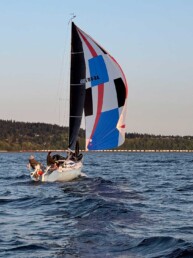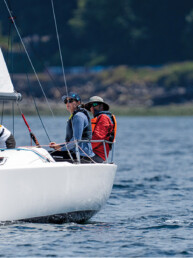From the January 2021 issue of 48° North.
Winter winds are here! It’s something to celebrate, but also something that requires special readiness. Being able to reduce sail to maintain better control of the boat is, of course, always important. This is especially crucial at this time of year.
Let’s zoom out, first. Boats are designed to sail best at a particular angle of heel — depending on the boat, somewhere between 10° and 20°. If the force of the wind on the sails causes the boat to heel more than that, it not only makes it harder to control and puts unnecessary strain on the rigging and the crew, but it is almost always a slower way to sail.
Reefing — the act of reducing the effective sail area to reduce the force the wind can apply to the boat — is one way to address this. Conventional wisdom offers the general rule: “If you are wondering if you should reef, you should already have a reef in.”
However, when and how to reef leaves lots of room for interpretation. Below, we will review some of the different kinds of reefing and how to make them work for you, your crew, and your boat during a particularly windy winter sail.
Before you get to tucking a reef in, remember that the first way to depower a sail is with the sail controls; and weather helm can guide you in this process. A few principles apply to this line of thinking:
A flatter sail has less power than one with more shape. Tightening the halyard, cunningham, outhaul, or the sheet and/or moving the traveler to leeward or headsail fairleads aft can all flatten and depower the sails. If your boat has an adjustable backstay, trimming the backstay on also flattens both main and jib.
All these sail controls will affect weather helm, which is the tendency of the boat to want to round up into the wind when it is overpowered. You always want a little weather helm, as keeping the bow from coming up creates lift to windward. It is also much safer for the boat to want to go bow-to-wind if you let go of the helm. As the wind increases so does the weather helm, so if it gets to be too much you will not be able to keep the bow down and/or will have to have the rudder so far over that it acts as a brake and slows the boat down. If sail controls are tight and you’re still struggling with excessive heel, a lot of weather helm, or both, it’s past time to reef. Remember, reefing when you first think about it is the best practice.
Reefing Approaches
Most often, when sailors think of reefing, they’re thinking of shortening the main first sail using a reefing system like Hook and Cringle. This is not the only option, but here are some considerations:
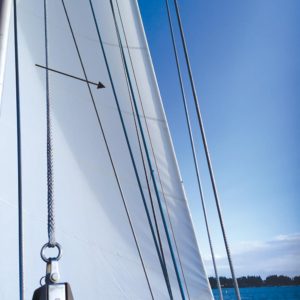
Roller Reefing: With furlers for roller furling headsails, in-boom and in-mast furling mainsails, we can shorten the sail by simply rolling it up on the furler. Unfortunately, these can be the most expensive reefing systems and the least effective, depending on execution. They are the most complicated and, by extension, the least reliable. However, they certainly have their advantages and can be well executed in their design, installation, and use.
The biggest problem with roller reefing is related to sail design. The designed draft (depth) in the middle of the sail dictates that, as the sail is rolled up, the edges of the sail roll proportionately faster than the middle of the sail (where the draft leaves more material). The resulting sail shape when partially rolled thus involves very tight sail edges while leaving the maximum draft area in the middle of the sail loose and baggy (Figure 1). This is exactly what you don’t want, because a loose sail with a lot of shape has more power and/or drag than a flat sail — resulting in poor upwind performance, more heel, and less control.

There are some clever designs to help with this problem. Lengths of foam sewn into the luff can help roll the sail more tightly and evenly for a better shape; and in-boom furlers are normally thicker in the middle to compensate for sail shape as the sail rolls up (as opposed to a simple straight bar). Another option is to roll the sail up so small that it is flat because the end of the sail has very little shape to it (Figure 2). With a headsail, the best way to shorten sail may be to take down the larger sail designed for light air, and put up a smaller one designed for heavier wind.
Slab Reefing: Slab Reefing, also known as Jiffy reefing (Figure 3), is the most common form of reefing you’ll see on sailboats with traditional mainsails these days. This involves having reef points on the sail that can form the new tack and clew when it is lowered, so that a slab of the sail is no longer used below the reef points.
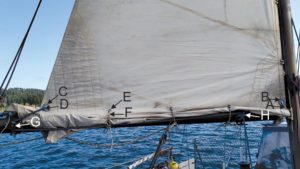
Hook and Cringle Reefing: Hook and cringle reefing is one of the simplest ways to secure this new tack. A hook is typically integral to the boom near the gooseneck and a sailor must go forward to attach the sail’s reef-point cringle to this fixed hook. The clew is then secured with a reefing line, usually rigged through the aft end of the boom, that thus becomes the new outhaul.
Two Line Reefing: The reef points on the sail used in slab reefing can also be secured each with their own lines (Figure 4). To reef, lower the sail to below the reef you wish to put in, tighten each reefing line to the proper tightness, then raise the halyard to tension the sail against the new tack and clew. Generally, each of these lines is run prior to sailing and is ready to employ from the cockpit. One way to save on reefing lines when using the two-line system is to have the cunningham attached to the sail by a hook (which could be used similarly to a fixed hook at the reefing cringle). While more efficient in terms of lines, it requires someone to go forward to attach the sail to the hook at its reef point, negating one of the benefits of a dedicated two-line system.
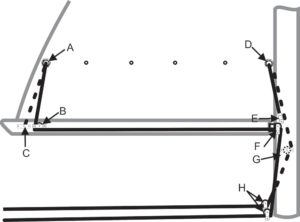
Single Line Reefing: This method works very much like two line reefing, except that one line is run through both reef points (Figure 5) and then only that line is tightened to secure the reef. This can be the simplest system to put a reef in, but can be one of the more problematic to get to work smoothly because it may have a lot of friction.
For the most part you can change your reefing system from one to the other as it suits your needs. If you don’t have in-mast or in-boom furling mainsail, roller reefing the main probably requires a new mast or boom … no small or cost-effective undertaking. But for the rest, they work similarly enough that they can be changed one for another. But why would you want to? Well, each sailor may want to identify their personal preferences in balancing ease, safety, and effectiveness. You want the reef to be easy to put in and shake out. It is almost always easier to shake a reef out than to put one in — hence the saying “reef early and often.” Many sailors would like to avoid going forward to put the reef in, if possible. Reefing setups altered to run all the lines back to the cockpit for easy employment may necessitate new lines, since existing lines may not have the length to work in this system.
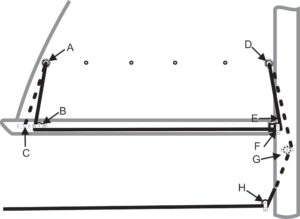
Ultimately, each of these systems has advantages and disadvantages. Hook and cringle is the simplest option as far as moving parts and friction: cringle goes over hook, re-tension the halyard, then tension the reefing line (probably with a winch mounted on the mast or boom), and you’re done. With two-line reefing, you can lead both reefing lines and the halyard back to the cockpit and do everything from there. This will require several more blocks, which will add friction, plus the attachment and lead points for the tack reefing line need to be properly placed. With some careful rigging and friction management, a single-line system may work even more easily.
Friction is a big factor in whether any system works smoothly for you. Low-friction ball bearing blocks and low-friction rings properly placed and used can help reduce the total friction by quite a bit, but also remember to keep them well lubricated.
Reefing is one of those step-by-step procedures where, when it is really needed, it is likely to be done in less-than-ideal conditions. Going through each and every step and seeing if it can be improved is the only way to make it as smooth as possible. Practice at the dock, time yourself, get some friends to compete with to see who can do it the fastest; and then see why and if there is a way to improve it. All systems involve compromises, and experience is the only way to know what will work best for you, your boat, and crew.
And don’t forget, you are a part of that system. The best reefing system for your boat is the one where you can put a reef in quickly, safely, and effectively, no matter how cold and strong the winter winds may blow.
Alex Wilken
Alex Wilken and his father, Jack, are lifelong cruisers, professional shipwrights, USCG licensed captains, and the owners of Seattle Boat Works.

